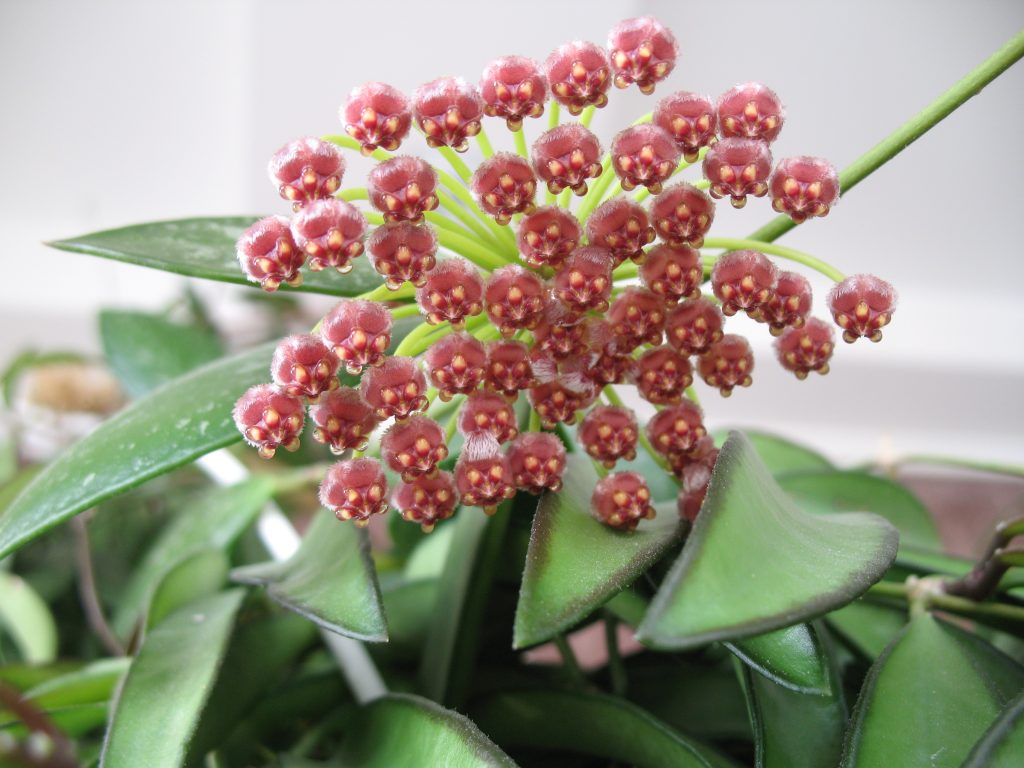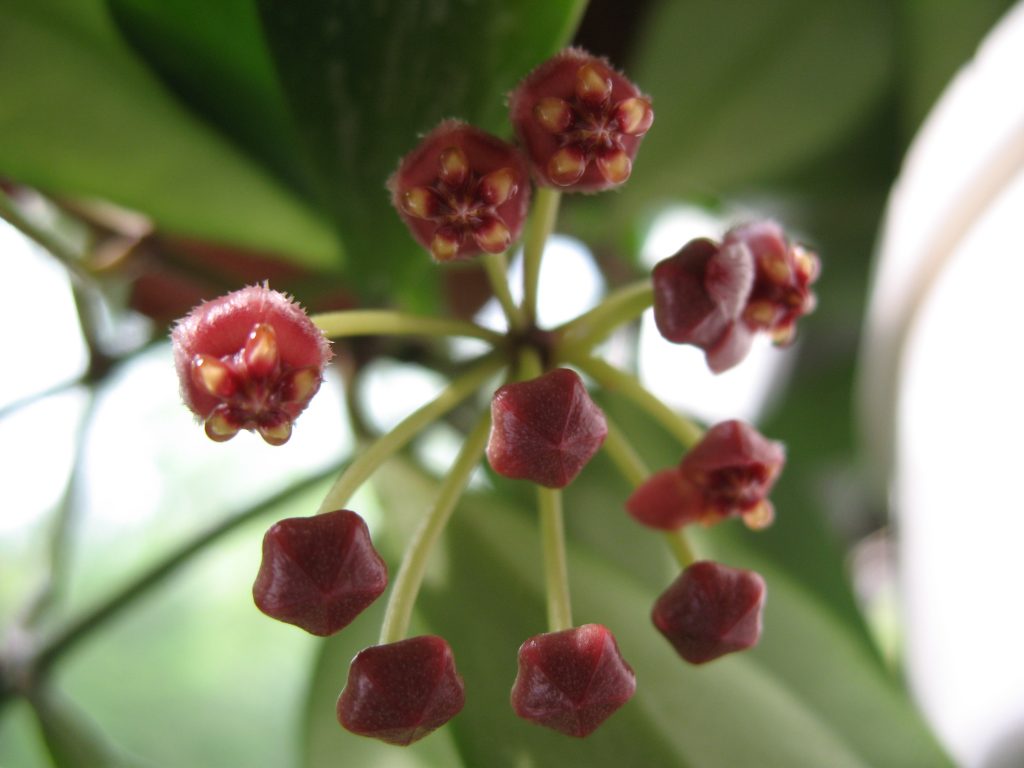Hoya Gracilis - variety description
Hoya Gracilis (Graceful) was introduced to Europe from the Philippines. The flower immediately fell in love with both professional florists and amateur florists. An unpretentious liana with unusual wax flowers and a strong pleasant aroma grows in the homes of lovers of green exoticism around the world.

Hoya gracilis
general characteristics
A plant with a thick, fleshy stem and wide, pointed leaves. On the dark green dense leaf plates, cream specks are barely visible. The back of them is covered with a light down. It grows in the form of a liana, shoots can reach 5 m in length.
With sufficient lighting, Hoya Gracilis acquires an interesting color: pinkish stripes appear on the leaves, and specks become more contrasting. The plant looks very beautiful and bright. It blooms for a long time, when favorable conditions are created all year round.
Flowers in the form of small stars bloom on long stalks, they are collected in graceful "umbrellas" of 20-25 buds each. The number of such inflorescences depends on the age of the plant and the conditions of detention.
If you organize the proper care of the hoya, then its graceful vines will be completely covered with fragrant flowers, regardless of the season.
Purchase and adaptation
Hoya is most often sold as rooted first-year cuttings. Their price ranges from 200 to 500 rubles. An adult plant, at the age of 3 or more years, will cost 2,500-3,000 rubles. Liana grows slowly, so even a three-year-old bush will look modest.

Hoya gracilis
It is imperative to adapt the flower after purchase. Even bred by a local grower, it can be infected with a bacterial or viral infection, and also contain eggs from insect pests. Imported plants need long-term quarantine and mandatory transplantation into a more suitable, pre-disinfected soil.
Having brought a flower into the house, you need to quarantine it and just observe for 2-3 weeks.
If there are no signs of the disease, then it is transplanted and put in a permanent place. If it becomes clear that it is infected, it must first be cured and only then placed next to the rest of the plants.
Boarding and transfer rules
Hoya does not like frequent transplants. It is better to keep an adult plant in one pot for 3-4 years, until roots begin to emerge from the drainage holes. Experienced flower growers, even in such cases, are in no hurry, claiming that in a cramped container the liana blooms more abundantly and longer.
Be sure to transplant the plant after purchase. Shipping containers with peat mix are not the best option for flower growth. You need to buy soil for succulents and prepare a new substrate from it. Drainage from shards and expanded clay is laid out in the selected container (it should not be much larger than the original one). Pour vermiculite with coarse sand and soil mixed with perlite on top.
It is helpful to add leafy earth for better nutritional value to the mixture.In such a substrate, hoya can do without additional feeding for a long time. The plant itself is taken out of the pot, shaken off the remnants of the peat (you can even wash off the roots under the tap) and transplanted into a new substrate.
Attention! The roots are washed off only at the first transplant after purchase. In the future, the plant is simply transferred into a new pot, without disturbing the earthen lump.
The necessary conditions
Having created the necessary conditions for the plant, it will be possible to enjoy its flowering at any time of the year. Hoya's fragrant buds are formed only with proper care. In the absence of due attention, the flower will live, but it will lose the decorative effect of the leaves and stop flowering.

Hoya gracilis photo
Humidity
Hoya is a succulent vine that can do without moisture for a long time. Therefore, an artificial increase in this indicator for a flower is not necessary. Even at 30% humidity, the plant feels great and blooms even without problems.
On hot days, spray with settled water. The flower responds well to such an additional "shower", releasing new peduncles. The main thing is that the water does not fall on the open flowers.
It is useful for the plant to bathe in the rain in the bath at least once a year, but the procedure should not be carried out during flowering.
Temperature
In summer, the temperature should be within + 22-26 ° С. Lianas are all thermophilic. Even the heat under +30 ° С will not give them much discomfort. With timely watering, high temperatures for hoya are preferable to low temperatures. In winter, a cold snap to 10 ° C and below will be disastrous.
This flower does not need a dormant period as badly as other indoor plants. With constant indicators in the region of +22 ° С, the hoya will always grow and bloom, regardless of the season.
Of course, the flower does not interfere with the rest, for this you just need to lower the temperature and reduce watering to a minimum, but it is rather difficult to fulfill this condition during the heating season.
Lighting
The plant needs a lot of light. Especially varieties with variegated leaves, to which Gracilis also belongs. With a lack of lighting, the leaves fade, their colors become pale, and flowering stops abruptly.
Liana looks good in hanging pots right on the windows, preferably south or southeast. The plant should not be turned - hoya does not like changing position relative to the sun. On the wall by the window, the flower will also be comfortable.
Care
For healthy growth and long flowering, the hoya must be properly cared for. Certain procedures should be done periodically, while others are contraindicated for the plant. All this needs to be studied in advance, even before purchasing an exotic liana.

Hoya gracilis photo and description
Watering
Although hoya has the properties of succulents, it requires abundant watering in summer. Depending on the air temperature, it is necessary to moisten the flower 2-3 times a week with settled water at room temperature. On cooler days, the amount of watering is reduced.
The water should be soft, preferably rainwater. In no case should you use tap water, because it has a high content of chlorine and heavy metals. This combination is especially dangerous for recently rooted cuttings and young plants up to a year old.
Top dressing
There are no special mineral complexes for hoya, but fertilizers for cacti and succulents are perfect for it. They begin to bring them in from early spring to the end of summer.
It is not recommended to feed vines with organic matter due to the risk of developing dangerous microflora.
The best complexes:
- Pocon;
- Etisso;
- Good power;
- Florovit;
- Stimovit;
- Joy;
- Uniflor Cactus.
Pruning
As the long shoots grow in the hoya, they must be pruned to stimulate the growth of the lateral branches. The first pruning is done in early March, then repeated monthly during the summer. This procedure causes the two kidneys to wake up under the cut point. The bush turns out to be more lush.
The main rule is not to remove faded peduncles. In liana succulents, the buds bloom on the same peduncle several times.If you cut them off, the flowering will stop. Then you will have to wait for new ones to grow, and this may take a year or more. Sometimes hoya, after incorrect pruning, loses its ability to bloom forever.
Reproduction methods
Hoya is easy to propagate in several ways. If you do everything right, you can get several young plants in a couple of months.

Hoya gracilis aroma
Seeds
At home, seeds rarely ripen. Most often they can be found in online stores or from the hands of experienced florists. The seeds are soaked for a day, then placed in a substrate of perlite and vermiculite. The container is covered with foil and placed in the light under a lamp. At a temperature of 27 ° C, sprouts appear in 14-20 days.
Cuttings
It is convenient to get cuttings during planned pruning. They root well both in water and in a nutrient substrate. Beforehand, the cutting is dipped in Kornevin's solution. For better germination, the roots are kept in a warm place. After 2 months, the cuttings take root and begin to grow actively.
Diseases and pests
| Problem | Cause | Treatment | Prophylaxis |
| Falling leaves | Dry air | Spray the plant | Spraying regularly in hot weather |
| Spots on the leaves | Lack of light | Place the flowerpot in a lighter place | Monitor lighting |
| Lack of flowering | Lack of light, nutrients | Fertilize, put in the light | Top dressing regularly |
| Falling buds and flowers | Heat, dry air | Spray the plant, ventilate the room | Monitor humidity and temperature |
| Blanching leaves | Lack of nutrition and root space | Transplant urgently into fresh soil | Transplant every 3-4 years |
| Spider mite | Fufanon, Actellic, Anti-tick | Regular inspection | |
| Shield | Neoron, Karbofos, Fitoverm | Regular inspection | |
| Powdery mildew | Low humidity, stale air | Topaz, Skor, Quadris | Ventilate the room daily |
Hoya of the Gratsilis variety is very graceful and beautiful, while it does not require painstaking care. Having once chosen the required mode of watering, pruning, fertilizing and transplanting, each grower will be able to enjoy its decorative effect and long flowering.

